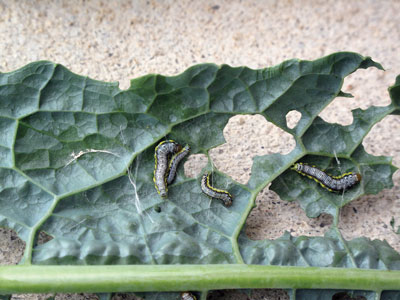10/1/2017
Controlling the Very Hungry Caterpillars
Karen Stever

Hungry caterpillars, the larvae of moths and butterflies, can wreak havoc on crops. Cutworms can be very destructive and are often the first to appear in the spring, as they overwinter in soil, mulch or wood. From late spring through summer, an array of these pests begins to hatch and make themselves known, including armyworms, cabbage worms, bud worms, fruit worms, assorted loopers, tent worms and numerous others.
Pictured: Cross-striped cabbage worms.
By late summer, egg laying has peaked and caterpillars of one type or another can be found just about anywhere in the landscape. Production for fall sales can make mums, cabbage, kale and pansies particularly prone to damage by feeding larvae. Vegetable crops may also be susceptible from season’s start to the end.
After eggs have been deposited on the plant, they can hatch in as little as four to five days or the eggs can overwinter in place, as with the notorious gypsy moth, to hatch the next spring. Biological control in the form of tiny Trichogramma wasps can be used to prevent eggs from hatching. These parasitic wasps attack freshly laid eggs (up to four days old), depositing their own eggs inside the moth egg. The beneficial wasps must be released prior to, or at the latest, just as the moths are flying and laying eggs. Starting releases prior to arrival of the moths will allow the parasitic wasp populations to build.
Trichogramma wasps mature from egg to adult in eight to 10 days. The adult wasps will reproduce on a diet of nectar, honeydew and pollen. They’ll lay up to 10 eggs per day during their seven- to 14-day life cycle.
Trichogramma pretiosum are supplied as parasitized moth pupae on cards (100,000 per card). One card treats up to 1 acre. The general predator bug, Orius insidiosus, will feed on caterpillar eggs, along with the thrips and spider mites it’s more frequently used to control.
Once egg hatch occurs, the clock begins ticking. Effective control of caterpillars is best achieved while the larvae are young and small. Killing them becomes progressively more difficult, as the voracious eaters rapidly gain size. In addition, each day (or night) of feeding increases the cumulative damage to the plant. Plants can become unsalable in just a few days.
Several naturally derived insecticides are very effective against the hungry larvae. These include: Conserve and Entrust (OMRI-listed), both of which have the active ingredient spinosad (MOA 5); natural pyrethrins, such as PyGanic (MOA 3, OMRI-listed); and the bacterial products DiPel (MOA 11, OMRI-listed) and Grandevo (MOA UN, OMRI-listed). These products can be used on most edible and ornamental crops, indoors or out. They’re generally safe for blooms and foliage of ornamentals.
While effective against caterpillars, these products are relatively safe for pollinators in the absence of direct contact. Read label directions and precautions. The re-entry intervals are four hours for these products—with the exception of PyGanic, which has a 12-hour REI.
Beyond the organic pesticides listed above, several broad-spectrum insecticides stand out as top picks for the purpose of controlling caterpillars on ornamentals. These include Decathlon (MOA 3), TriStar (MOA 4A) and Mainspring GNL (MOA 28).
Of these chemical options, TriStar has the best pollinator profile with low toxicity and a very short residual effect on bees. TriStar has been shown to have some ovicidal activity, in addition to acting on the larvae. TriStar is labeled for the use at the transplant stage of several edible crops and has a 12-hour REI.
Mainspring GNL is the only product here that can be used in a spray or a drench application; it has the longest residual activity, is relatively safe for beneficial insects and has a four-hour REI. Mainspring GNL is not labeled for edible crops.
Decathlon remains one of the few synthetic pyrethroids that’s not labeled as a restricted-use pesticide in most states; it carries a 12-hour REI and is not labeled for edible crops.
Historically, broad-spectrum pyrethroids (MOA 3) and organophosphates (MOA 1) have been widely used for caterpillar control. These products remain effective, but environmental concerns should normally steer our chemical choices to the options presented above when possible. To ensure efficacy and safety, always read the label for specific uses and restrictions.
GT
Karen Stever is a GGSPro Technical Support Representative for Griffin. She can be reached at ggsprotech@griffinmail.com.